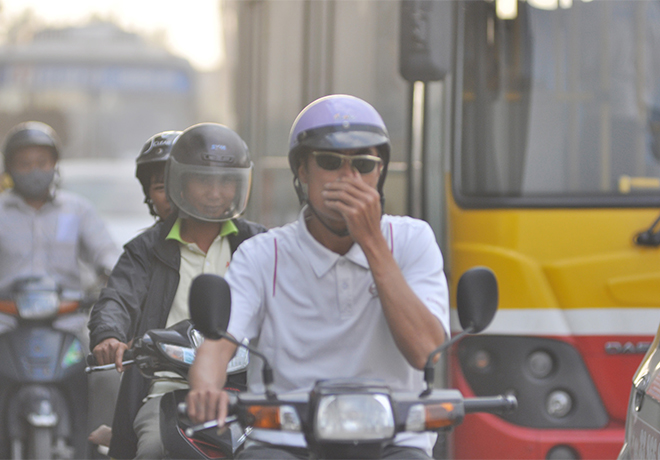Air pollution in big cities of Vietnam is growing at an alarming rate and needs more positive measures to limit.

Pollution is still increasing
According to Dr. Le Viet Phu, an economist at the University of Fulbright, the author of the research project "Estimating Health Damage and Economic Costs of Air Pollution in Ho Chi Minh City", air pollution in Vietnam has caused up to 5% of annual GDP. The concentration of dust in the air increases very fast. The annual average has exceeded the WHO warning threshold to 3 times and brings the risk of disease and death to the people. As estimated in 2013, Vietnam has up to 40,000 deaths related to air pollution (due to PM 2.5 dust particles).
Delivering a speech at the recent talk about air quality in Hanoi, Prof. Nghiem Trung Dung – the Institute of Environmental Science and Technology, Hanoi University of Technology – emphasized that there were many reasons for increasing the level of urban air pollution, in which, traffic is a major cause.
Particularly, in Hanoi, there are more than 7 million people, accompanied by the same number of personal vehicles. It is predicted that the number of private vehicles will increase in the coming time. Specifically, by 2020, there will be 843 thousand cars, 6.1 million motorcycles; by 2025, there will be 1.45 million cars and 7 million motorcycles and 20 million; by2030, there will be 2 million cars and 7.5 million motorcycles. Therefore, the control of emissions from vehicles has been a matter of extreme urgency. In addition, air pollution is also a result of economic growth, investment attraction, population growth… in many big cities.
Talking about this issue, Ms. Nguyen Thi Khanh, Green Innovation and Development Centre (GreenID), said that Vietnam was near the bottom of the rankings (in 2016) of Yale University for air quality at the rank of170/180 countries. This is the reason why there are a number of questions: Does Vietnam need to adopt new regulations to protect the environment or simply extend existing regulations such as gas taxes? Should these rules place greater responsibility on the business community? Is it time for 92 million Vietnamese citizens to encourage walking or using public transportation instead of riding a motorbike or driving a car?
A breakthrough solution is needed
Objectively, in order to reduce the air pollution,the large cities are implementing many solutions simultaneously. The most visible evidence is that Hanoi has been actively promoting the planting of 1 million trees by 2020. In addition, the Hanoi People's Council has also approved the scheme of vehicle management, development of public transport to minimize air pollution caused by transportation activities. This is a project highly appreciated by experts and researchers because it will "block" pollution from the root.
In Ho Chi Minh City, the government has set a target that 90% of industrial companies will have to install air pollution treatment systems to reduce 70% of air pollution at the same timeby 2020.
However, in the long run, according to experts, in addition to having to have suitable policies to protect environment sustainably in the long term (via the restructuring of economic sectors), Vietnam needs to improve the legal system on environmental protection; in which, the sanctions must be strong enough to deter violators and the proportion of budget for environmental activities must be suitable. Moreover, the investment in energy production must be diversified, except the energy from burningcoal. The use of clean energy sources and energy saving equipment must be encouraged...
Ms. Nguyen Thi Khanh proposed that it was time for us to issue a law on "clean air". In another perspective, Dr. Le Viet Phu noted the need to reduce high pollution industries and projects. At the same time, we must shift from simple economic growth to sustainable economic growth ensuring economic growth, social security and environmental protection. In the longer term, the cities also need to plan and dispose of exhaust gases to serve the socio-economic development planning.
K.Linh